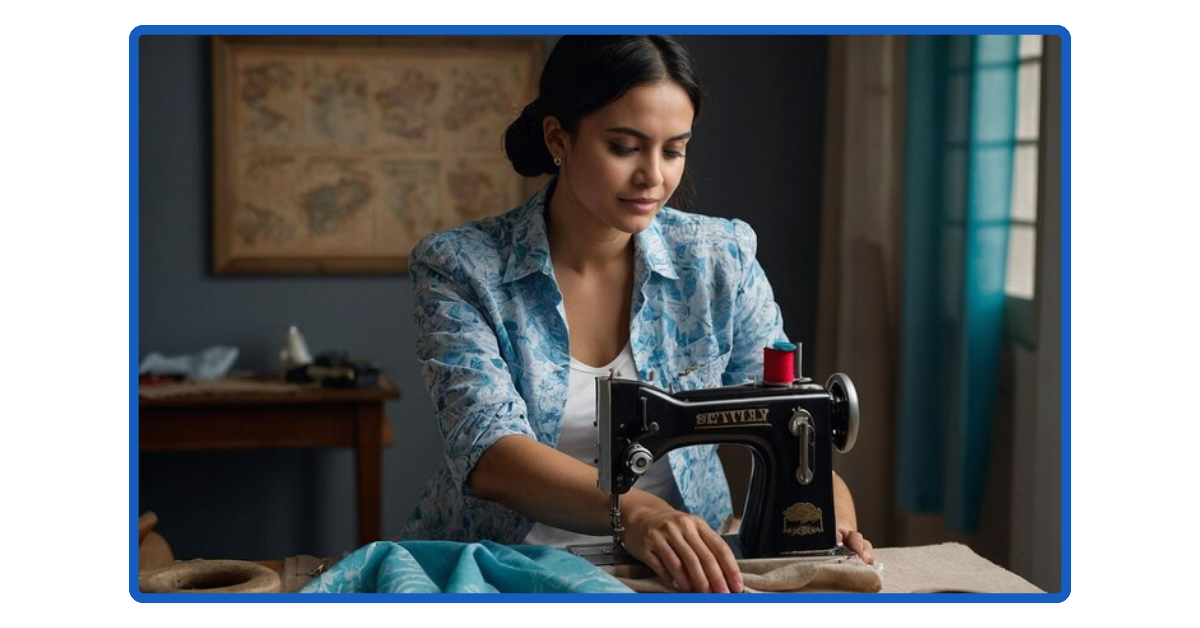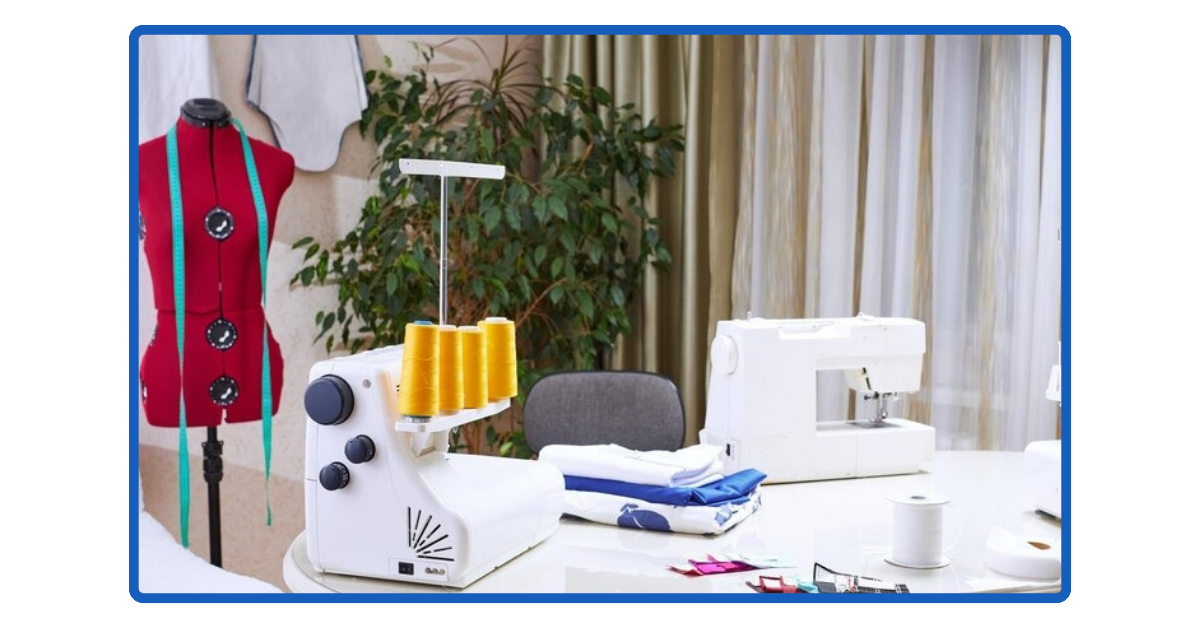Due to the rapidly changing society, many talented people are considering starting their own businesses from home. One such rewarding business is tailoring. this field is impressive with numerous unidentified prospects for everyone who may want to start his own business.
The fashion industry encompasses manufacturing clothing and fashion products and trading. Thus, stitching business from home appears lucrative for professional business persons. Here, we’ll talk about turning your local tailoring shop into a business.
You can easily start a stitching business at home if you know sewing and some needlework. However, many people need help with where and how to start. Worry not! This blog will cover all the essential steps on how to start a stitching business at home.
Why Start Stitching Business at Home?

Starting a stitching business at home gives you the freedom to make decisions. You’re free to set your own schedule and follow your passion. You can create unique outfits by bringing your design ideas to life. Apart from this, you experience the following advantages from the business:
Flexible Work Hours
A home-based stitching business allows you to set your own hours, balancing work with family and personal interests. Compared to dedicated jobs, you need not report to your manager for taking a short rest from work. You are free to plan your work to your satisfaction. Independency of work is the foremost benefit of starting a stitching business at home.
Low Overhead Costs
Almost every business requires a considerable amount of investment. Therefore, many people hesitate to start their venture. However, you can save hefty rent and utility bills investments by starting a stitching business at home. You can use these savings to make quality materials and publicize your business. All you need is a sewing machine and other small stitching tools.
Large Profit Margins
As you spend the minimum in this business, every earned penny counts toward your profit. You can make great profit margins by providing customized services such as alterations and custom-made designs to your customers. You can set distinct prices for different dress kinds you make. For example, charges for designing and creating a bridal dress can be higher than sewing a school uniform. Prices offered for some of the services in India are as follows:
Dress Alteration – ₹ 50 to ₹ 200
Blouse stitching – ₹ 300 to ₹ 500 (according to design and accessories)
Kurta making – ₹ 200 to ₹ 300 (according to design)
Men’s Suits — ₹ 10,000 to ₹ 20,000 (including fabric)
Women’s Outfits — ₹ 5,000 to ₹ 25,000 (including fabric and accessories)
Potential to Grow
The global boutique sector is growing at a 3 to 5 percent CAGR in 2024. The clothing industry in India was worth about 59 billion dollars in 2022. It is expected to grow at a rate of more than 25% by 2028.
Hence, the stitching business can make more growth than other small businesses. As you know, the demand for newly designed clothes and dresses is always rocketing. Therefore, this business will progress in the future and your efforts will pay off.
Steps to Start a Stitching Business at Home
It is advisable to carefully make detailed plans before starting any business. The art of sewing involves creating stylish and comfy clothing for clients, which goes beyond simply stitching with a needle. Thus, here is a manual on how to start a stitching business at home.
Step 1: Evaluate Your Skills
Assessing your skills will help you understand where you stand and how you can grow. Are you a beginner, intermediate, or an expert tailor? Consider areas of your expertise and improvement.
Don’t hesitate to get training in lacking skills, if needed.
You can evaluate your creativity and stitching skills by reviewing previously completed works. This business requires time and effort to make the most exquisite and artistic pieces.
Step 2: Research the Market and Select Your Niche

It is an essential part of a successful business plan. This enables one to estimate the market, the trends, and the competition in the sewing industry. See what your potential clients can look for in you.
Gather information on the current price structure of stitching services being offered to customers by home-based dressmakers. Find out how many potential customers can you have in the market.
You can select one stitching service or provide all the sewing services. Examples of niches in the stitching business are:
- Custom Clothing: Sewing clothes for clients who want personalized outfits for special occasions like weddings and parties.
- Alteration and Repair: Fixing and modifying already stitched clothes.
- Children’s Clothing: Designing and creating outfits for little ones.
Step 3: Acquire Permissions for Your Business
You need to register your business officially. Find out what licenses are necessary to start a stitching business from home.
Certain regions require a particular home occupation permit to run a business from home.
For more details, you must consult a business advisor who will help you understand the business norms and regulations.
Step 4: Set Up Workspace at Home

Organize your environment and personal comfort for the day’s work. For instance, a brightly lit part of your home such as near a window will be ideal when working on fabrics with specific stitches. Use properly designed furniture like chairs and tables for higher output and productivity.
A stitching business can be started at home by setting up the minimal necessary equipment. Such as
Sewing Machine: Although these machines are inexpensive, go for a good quality sewing machine with different stitch options and speeds. You can use a multitasking electric machine that will suffice all your requirements.
Cutting Table: Another necessity is a table on which the fabrics must be cut. It should be spacious enough for cutting.
Ironing Equipment: Iron and ironing boards are required to press the seams of the dresses and give them that professional touch.
Storage Cabins: Another thing that should be managed properly are threads, needles, scissors, chalks, and other tools. These should be stored in appropriate storage boxes with labels. You should store your collection in clear bins or on shelves to display to your customers.
Step 5: Purchase Materials for Your Stitching Business
As for acquiring the fabric you can either buy it from the physical stores around you or through online applications.
You can obtain apparel fabric and sewing accessories that include threads, bobbins, and needles from local fabric and craft stores. You must request a wholesale price If you are a constant buyer and buy products from these stores in bulk.
Presently, many vendors who deal in fabric and threads can be easily found on online selling websites such as Amazon and Etsy. However, one has to choose good quality materials at an affordable price.
Step 6: Promote Your Home-Based Stitching Business

Choose a memorable and captivating name for your business brand. You can also create the logo using available logo maker apps for your brand name. In another way, hire professionals to make your brand logo.
For local marketing, promote your business by word of mouth in your existing friend circle and network. You can also participate in local exhibitions or events to display your work on a large scale.
Nowadays, online presence is a must to publicize your business. Here’s how you can make your business visible to the audience:
- Website: Creating a simple website to showcase your portfolio, services, and contact information can boost your online presence. Improve the website for local search to ensure that your business is the top result for people in your region on a search engine.
- Social Media: Utilize social media websites such as Facebook, Instagram, and Pinterest to post photos of your work and feedback from clients. You have the option to work together with influencers in your area and share content on social media platforms.
Online marketing is an ongoing effort. You can join hands with reliable digital marketing companies to manage your online presence on search engines and social media platforms.
Step 7: Manage Customers
Talk to clients about their demands, requests, and any particular design they would like for their orders. It is said that quality sells, you must put in your work. You have to ensure that you answer your client’s questions regarding their order satisfactorily. Make sure you complete your raiders in the set time.
Also, remember that it is important to ask for feedback on your work from the buyers upon ending an order. Doing advancement by using clients’ feedback as a reference makes a business grow.
Step 8: Explore Growth Opportunities

It’s crucial not to limit yourself to the stitch context only. Consider the following ways to expand your stitching business:
- Workshops and Classes– If you are good at something, why not start teaching the hobbyists and the learners who are new to such fields? This would assist your stitching business to penetrate the market further than your locality.
- Collaborate with Boutiques– Approach boutiques to have them display your designs for sales, with the agreement of making percentage sales with them.
You may also display your creations to the general public through events like exhibitions.
- Online Sale– All firms have an opportunity to extend their business on online selling applications such as Etsy and Meesho by starting an online store. Use Instagram, Facebook, and other social media platforms to display and sell your designed outfits directly to the customers.
Overhead Costs of Starting a Stitching Business at Home
Calculating the finances required to start a stitching business at home helps you prepare a plan for your business expenses. You can apply for a business loan knowing your financial requirements. The approximate investment needed to start a stitching business at home falls within the following range:
Sewing Machine – ₹5,000 to around ₹20,000
Sewing Tools – ₹1,000 to ₹5,000
Cutting Table – ₹ 1,000 to ₹25,000
Iron – ₹500 to ₹5,000
Fabric – ₹5,000 to ₹20,000
The processing fee for boutique licenses in India ranges from ₹500 to ₹12,500.
Marketing Expenses – ₹10,000 to ₹50,000 (Depending on marketing strategies used and the digital marketing company)
The overhead expenses for a home-based stitching business will fall around ₹25,000 to ₹100,000.
Final Words
Starting a stitching business from home is a highly rewarding endeavor that many people would desire to begin. This happens because there will always be a high demand for clothing in both the local and international markets. All you need is, to assess your capabilities and start your journey in the sewing sector. Promote your business locally via word of mouth, business events, and partnerships.
When it comes to digital, let social media weave your business growth. Partner with a reliable online marketing agency such as New Traffic Tail to market your home-based sewing business effectively.
We trust that this manual has provided you with insights on how to start a stitching business at home and grow it. If you have any additional questions or feedback, please don’t hesitate to leave them in the comment section. We’ll appreciate your engagement. Happy Stitching and Good Luck!
FAQs
Q1. How can I be sure that my sewing skills are fit for a business?
Compare your work with the other tailors and seamstresses within your region. Look for the new trends in the sewing designs to see if you can create them or not.
Q2. What must I do to balance a house and a sewing business?
Determine whether the physical requirements of the work and clients’ schedules fit your life. Manage your free hours from home chores and invest them in your business. Select the area in the household that will be specifically used for your business.
Q3. How can I promote my home-based stitching business?
Make use of social media apps like Facebook and Instagram to interact with a wider audience. You can also take the help of an efficient digital marketing agency such as New Traffic Tail to manage your online promotion and create a strong digital presence.
Q4. How can I choose the right marketing company for my stitching business?
Look for a company with significant marketing experience in the sewing and fashion industry. Check the company’s website to learn about their clients’ reviews. Compare the service charges of various firms and choose the one that fits your budget.




